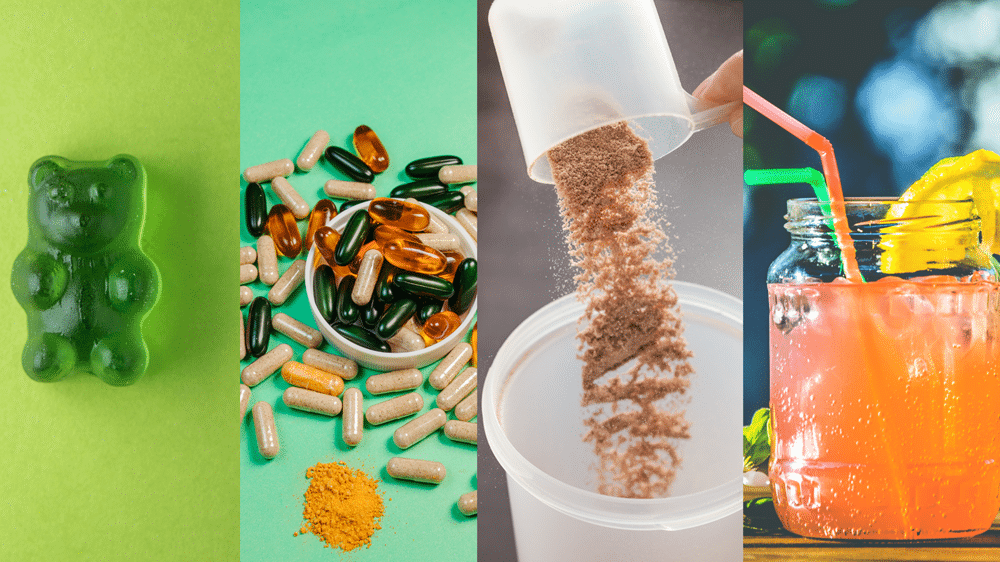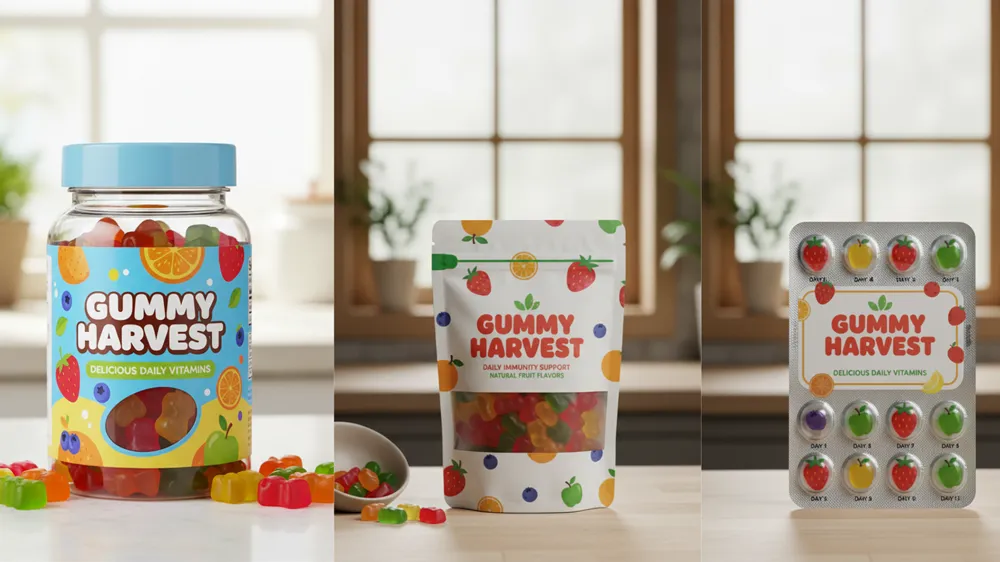
Introduction
Liquid supplements and gummies are two common forms of nutritional supplements. Liquid supplements, presented in liquid form (such as drops, tinctures, or beverages), are easy to swallow directly or mix with other drinks. Their main advantage is rapid absorption, as the nutrients are pre-dissolved and quickly enter the bloodstream, making them suitable for situations requiring immediate results, such as rapid vitamin or mineral supplementation. However, they may have a less palatable taste and require careful sealing to prevent oxidation during storage. Gummy supplements, on the other hand, come in jelly-like form, similar to candy, easy to chew and carry, and especially popular with children and those who dislike swallowing pills. Added fruit and sweet flavors improve compliance, but disadvantages include slower absorption (requiring dissolution in the stomach), potential sugar or artificial additives leading to increased calories, and the loss of some nutrients during processing. Overall, the choice depends on personal preference, absorption needs, and convenience; liquids prioritize efficiency, while gummies prioritize fun.
Understanding Supplement Absorption
The meaning of “absorption rate”
“Absorption rate” refers to the time required for nutrients to enter the digestive system after ingestion and ultimately be absorbed into the bloodstream and transported throughout the body. It reflects the efficiency with which nutrients are converted from food or supplement form into a usable form and taken up by cells. A simplified explanation of the nutrient absorption process is as follows:
Mouth: After ingestion, food or supplements initially come into contact with salivary enzymes (such as amylase) in the mouth, beginning to break down carbohydrates. However, absorption is limited; the majority of absorption occurs primarily through small amounts of certain water-soluble vitamins (such as B vitamins) directly entering the bloodstream.
Stomach: Food enters the stomach, where it is further broken down into proteins and minerals by gastric acid and enzymes (such as pepsin). Some water-soluble nutrients (such as vitamin C) begin to be slowly absorbed, but the stomach is primarily responsible for mechanical digestion and sterilization, resulting in a slow absorption rate.
Small Intestine: This is the main site of absorption. Semi-solid food is completely broken down here by pancreatic juice, bile, and intestinal enzymes. Nutrients pass through the villi on the small intestinal wall into the capillaries, where they are converted into glucose, amino acids, fatty acids, etc., rapidly entering the portal venous system and eventually reaching the liver and the entire bloodstream. This entire process typically takes several hours.
The faster the absorption rate, the more quickly nutrients can exert their effects, but this is also affected by a variety of factors.
Factors affecting absorption
Nutrient absorption efficiency (including rate and bioavailability) is affected by the following factors, which alter the processes of nutrient breakdown, transport, and utilization:
Nutrient form (vitamins, minerals, herbs): The chemical form of different nutrients determines their solubility and stability. Water-soluble vitamins (such as B vitamins and vitamin C) are absorbed relatively quickly, primarily through passive or active transport in the small intestine, but are easily affected by pH. Fat-soluble vitamins (such as vitamins A, D, E, and K) require emulsification in bile for absorption, resulting in a slower absorption rate. Minerals such as iron require chelated forms (such as iron chelates) for efficient absorption; otherwise, they may bind with phytic acid in food, reducing their bioavailability. Herbal extracts (such as curcumin) often need to be combined with extracts like piperine to improve bioavailability; otherwise, the absorption rate may only be 1-2%.
Delivery Systems (Liquid vs. Gummies vs. Capsules): Liquid supplements are pre-dissolved, bypassing some digestive steps and released rapidly in the mouth or stomach, resulting in the fastest absorption (usually entering the bloodstream within 5-30 minutes). Capsules dissolve in the stomach, with moderate absorption (30-60 minutes), but the fat-soluble components protect the nutrients. Gummies require chewing and dissolve completely in the stomach, like candy, resulting in the slowest absorption (delaying absorption by 20-60 minutes), and processing may result in the loss of some active ingredients or added sugar affecting overall efficiency.
Individual Differences (Age, Gut Health, Metabolism): Absorption slows with age; for example, reduced stomach acid in older adults leads to a decrease of over 30% in B12 and calcium absorption. Poor gut health (such as dysbiosis or inflammatory bowel disease) can disrupt villus structure, reducing overall absorption by 20-50%. Individuals with high metabolic rates (such as young people or athletes) have higher enzyme activity and absorb nutrients faster, but drug interactions or diets (such as high-fiber diets) may interfere with the transport of specific nutrients. It is recommended to adjust intake according to individual circumstances and consult a doctor.
How Liquid Supplements Work?
Mechanism: Nutrients are already dissolved → Less digestion required
The absorption mechanism of liquid supplements primarily relies on their pre-dissolved state, meaning that nutrients (such as vitamins and minerals) are already dissolved in the liquid before ingestion. This significantly reduces the digestive system’s breakdown requirements. Typically, solid supplements need to dissolve gradually in the stomach and small intestine through enzymes and acids, while liquid forms can be released directly in the mouth or stomach, bypassing some mechanical digestive steps and thus accelerating the transport of nutrients to the intestinal villi and into the bloodstream. This mechanism is similar to the efficiency of intravenous injection, but still requires active or passive transport through the intestinal wall.
Typical absorption rate: Potentially faster entry into the bloodstream
The typical absorption rate of liquid supplements is generally higher than that of solid forms. Nutrients can begin to enter the bloodstream within 5-30 minutes after ingestion, while tablets or capsules may take 30-90 minutes. This is due to higher bioavailability; studies show that the absorption efficiency of liquid vitamins can reach over 90%, especially for water-soluble nutrients such as vitamin C and B vitamins. However, the actual rate is still affected by individual factors, and not all nutrients (such as fat-soluble vitamins) are absorbed equally quickly.
Advantages
Rapid Absorption: As mentioned above, the pre-dissolved form allows nutrients to work faster, making it suitable for situations requiring immediate replenishment, such as athletes or those with hypoglycemia.
Easy to Swallow: Liquids require no chewing or large gulps, making them especially suitable for the elderly, children, or those with swallowing difficulties, reducing the risk of choking.
Suitable for People with Digestive Problems: For those with insufficient stomach acid or intestinal malabsorption (such as Crohn’s disease patients), liquids reduce the digestive burden and improve overall utilization.
Disadvantages
Shorter Shelf Life: Liquids are susceptible to oxidation, light, and temperature, with a shelf life typically of 6-24 months, far shorter than the 2-3 years of solid supplements.
Potentially Unpleasant Taste: Many liquid supplements have a bitter or medicinal taste, requiring the addition of sweeteners to mask it, which may not be suitable for those with sensitive taste buds.
Sometimes Preservatives or Refrigeration Required: To prevent bacterial growth, preservatives such as sodium benzoate are often added, or refrigeration is required, which may increase the risk of allergies or make them inconvenient to carry.
How Gummy Supplements Work
Gummy supplements are made by combining nutrients with gelatin or pectin to create a chewy texture. They need to be broken down in your stomach before the nutrients are released and absorbed.
Advantages
Tasty and enjoyable: Gummies are flavored like fruit or candy, masking any bitter or unpleasant tastes, which encourages regular intake—especially for children, picky eaters, or anyone who dislikes swallowing pills.
Easy to swallow and take: No need to swallow large capsules; simply chew and enjoy, reducing choking risks and making them ideal for kids, seniors, or those with swallowing difficulties.
Convenient and portable: They’re mess-free, travel-friendly, and don’t require water, fitting easily into busy lifestyles or on-the-go routines.
Gentle on the stomach: Often easier to digest than hard tablets, with less irritation for sensitive guts, and they may improve compliance by feeling less like medicine.
No unusual smell: Unlike some pills or liquids, gummies are odorless, enhancing the overall experience.
Disadvantages
High sugar or artificial sweetener content: Many gummies contain added sugars (up to 3-5 grams per serving) or sugar alcohols, contributing to extra calories, potential blood sugar spikes, and increased risk of weight gain or diabetes management issues.
Unreliable nutrient dosing and potency: They may deliver inconsistent or lower amounts of vitamins/minerals than labeled (e.g., up to 20% less in some tests), and potency can degrade over time due to a shorter shelf life.
Slower absorption rate: As chewables, they require dissolution in the stomach, delaying nutrient uptake by 20-60 minutes compared to liquids, potentially reducing bioavailability.
Risk of overconsumption: Their candy-like appeal can lead to accidentally taking too many, increasing the chance of vitamin toxicity or excess calories, especially in children.
Dental health concerns: Sticky sugars and citric acid can erode tooth enamel, cause cavities, or irritate gums if not followed by thorough brushing.
Limited inclusion of certain nutrients: Often exclude key minerals like iron or calcium due to formulation challenges, and may include artificial colors/flavors that some people prefer to avoid.
Liquid vs. Gummy: A Quick Comparison
| Feature | Liquid Supplements | Gummy Supplements |
|---|---|---|
| Absorption Speed | Typically faster | Slightly slower |
| Bioavailability | Higher potential | Moderate |
| Ease of Use | Easy to swallow | Very convenient |
| Shelf Life | Shorter | Longer |
| Taste & Texture | Can vary | Usually pleasant |
| Best For | Quick absorption, elderly, digestive issues | Taste, compliance, portability |
Which One Should You Choose?
Both forms have their strengths:
- ✅ Choose liquid supplements if you want faster absorption or have trouble digesting tablets.
- ✅ Choose gummy supplements if you care about taste and consistency — you’re more likely to take them every day.
Ultimately, the best supplement is the one you’ll take consistently and that fits your body’s needs.
If possible, talk to your healthcare provider about which form is better for your specific nutrient goals — especially if you have digestion issues or dietary restrictions.
Final Thoughts
So, is liquid really faster than gummies? Yes, in most cases — but the difference isn’t dramatic. What matters most is not just speed, but absorption efficiency, formulation quality, and daily use.
Whether you sip your vitamins or chew them like candy, the goal is the same: keeping your body nourished and balanced.
If you’d like to know the complete guide to gummy supplements, please check out another article or contact us for more information.



